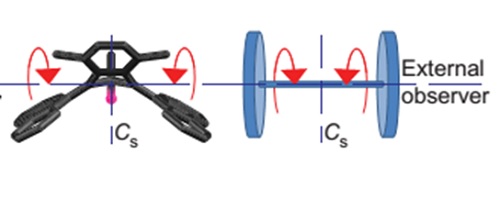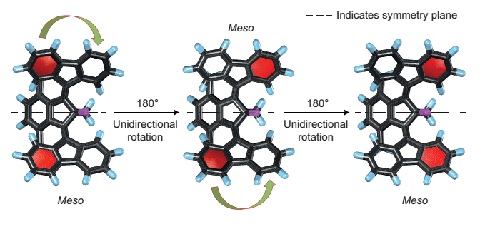New molecular motor mimics two wheels on an axle
University of Groningen scientists led by Professor of Organic Chemistry Ben Feringa have designed a new type of molecular motor. In contrast to previous designs, this molecule is symmetrical. It comprises two parts, which are connected by a central ‘axle’ and rotate in opposite directions, just like the wheels of a car. The results, which were published on Monday 12 October in the journal Nature Chemistry, would be ideal for nano transport systems.
It may sound odd, but from the perspective of the driver, the wheels on the left and right hand side of a car turn in opposite directions. When a car drives forward, the left front wheel turns clockwise and the right front wheel anti-clockwise. This is also the basic design of a new type of molecular motor from the lab of Ben Feringa, the creator of the first light-driven molecular motor back in 1999.

‘If you want a molecular motor to be of any use, you need to be able to control the rotary motion’, says Feringa. Up to now, this was done by using what are known as chiral molecules. These consist of two mirror-image parts, like a left and right hand, which are connected at a central point. ‘These motor molecules are therefore asymmetrical, and this difference between the two halves dictates the way it turns’, Feringa explains.

In Nature Chemistry, Feringa’s group presents the first symmetrical motor molecule with controlled rotary motion. Feringa: ‘This symmetrical motor, which is light-driven just like our other molecular motors, has two rotation axles and two rotating parts.’ The axles are attached to a central part, which is also symmetrical, with the exception of one carbon atom. This atom has two different chemical groups attached to it, which force the rotating parts to turn in opposite directions, as seen from the central part.

Just like a car, this means that the two ‘wheels’ make the molecule move in one direction. ‘This discovery has fantastic implications for realizing autonomous motion on the nanoscale, such as transport over a nano road in a predetermined direction’, Feringa explains. ‘We are now working in our lab to make this type of nano transport a reality.’
Reference: Unidirectional rotary motion in achiral molecular motors. Jos C. M. Kistemaker, Peter Štacko, Johan Visser and Ben L. Feringa. Centre for Systems Chemistry, Stratingh Institute for Chemistry and Zernike Institute for Advanced Materials, University of Groningen.
| Last modified: | 11 February 2025 2.44 p.m. |
More news
-
03 April 2025
IMChip and MimeCure in top 10 of the national Academic Startup Competition
Prof. Tamalika Banerjee’s startup IMChip and Prof. Erik Frijlink and Dr. Luke van der Koog’s startup MimeCure have made it into the top 10 of the national Academic Startup Competition.
-
01 April 2025
NSC’s electoral reform plan may have unwanted consequences
The new voting system, proposed by minister Uitermark, could jeopardize the fundamental principle of proportional representation, says Davide Grossi, Professor of Collective Decision Making and Computation at the University of Groningen
-
01 April 2025
'Diversity leads to better science'
In addition to her biological research on ageing, Hannah Dugdale also studies disparities relating to diversity in science. Thanks to the latter, she is one of the two 2024 laureates of the Athena Award, an NWO prize for successful and inspiring...
